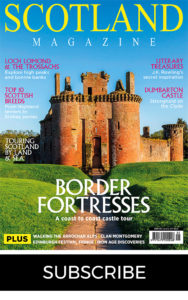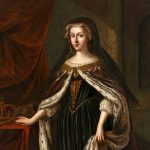MORE FROM SCOTLAND MAGAZINE
The Stewarts: Founding the Stewart dynasty
Following the downfall of the Bruces, the Stewarts, Scotland’s most famous royal family step out of the shadows
Words by Kirsten Henton
The death of David II, son of Robert the Bruce, in 1371 marked the end of the Bruce reign and the bloody beginnings of the Stewart dynasty, one that would rule Scotland for 343 years.
While war with England was largely kept at bay through various truces and the Auld Alliance with France remained predominantly intact, the first Stewart monarchs battled internally with issues of legitimacy, both old and young ascendants to the throne, and attempted power grabs by strong, rival families.
Despite this, the founding Stewart fathers did eventually instil a firmer, if heavy-handed approach to royal governance, instigating reforms and securing the foundations of the dynasty that would ultimately unite the Scottish and English thrones centuries later in 1603.
ROBERT II
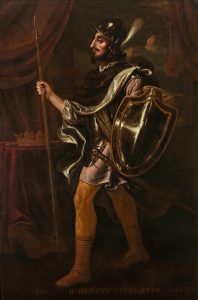
Robert Stewart, maternal grandson of The Bruce, waited long in the wings for his heirless uncle David II’s demise and was eventually crowned in 1371 at the unusually mature age of 55. From guardian of Scotland and battles with England to years of politicking and his virile antics evidenced by his multiple children, legitimate or otherwise, Robert II was well-seasoned when he became king.
While he benefitted from a period of relative stability – the English preoccupied with matters in France – Robert focused on shoring up his domestic support. To this end, he was quick to put his sons (and strategically marry off his daughters) into influential positions across Scotland creating a strong but feared power base.
His youngest son Alexander, for example, gained a rather brutal reputation as the ‘Wolf of Badenoch’ for the way he and his merry band of mercenaries ruthlessly controlled and pillaged the Highlands.
Robert’s undoing came from within. In 1383, aged 68 and in poor health, he was, as Timothy Venning writes in The Kings & Queens of Scotland, “pushed aside by his heir,” his eldest son, John, Earl of Carrick, who was appointed guardian. Yet, within five years, power was handed to John’s younger brother, the aggressive Robert Stewart, Earl of Fife, probably because of John’s lameness due to an unfortunate accident involving a horse kick.
Robert II died on 19 April 1390; he’s not fondly remembered as a king. As Venning says, Robert’s legacy is that of “a ‘mafia state’ run by a feuding clan dominated… by ruthless operatives.”
ROBERT III
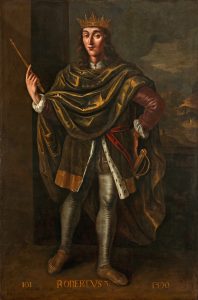
You’d be forgiven for thinking Robert III was Robert Stewart but that would be far too simple. Following Robert II’s death, his eldest son John, Earl of Carrick, changed his name, aligning himself with his great-grandfather, Robert the Bruce, in an artful piece of propaganda.
However, Robert III’s reign was not an especially happy one. Crowned at around 53 years old, he was, as podcast Rex Factor says, “well past his best when he became king,” and his brother, Robert Stewart, Earl of Fife, unwilling to give up power, retained guardianship of Scotland until 1393.
His grip on authority was not to last, though. In 1399, owing to Robert III’s officially proclaimed ‘‘sickness of person’’, parliament appointed his eldest son, David, now Duke of Rothesay, as lieutenant of Scotland. David was young, clever, and ambitious, though Venning says, “the family struggle continued between Fife and David,’’ and David’s rule remained under the supervision of his uncle, Robert Stewart, now Duke of Albany.
This new arrangement, predictably, culminated in the murder of David in 1402, preceding the capture of Robert III’s remaining heir and son, 11-year-old James, by pirates in 1406. The boy, who was attempting to reach the safety of France, was taken to England’s King Henry IV who held him for ransom.
Grief-stricken and overshadowed, Robert III died soon after. The Duke of Albany took the reins of power and was quite content to leave James south of the border. Contemporary Scottish chronicler, Walter Bower, wrote that Robert III wished to be buried in a ‘dunghill’ accompanied with the words: ‘Here lies the worst of kings and the most wretched of men in the whole kingdom’.
JAMES I
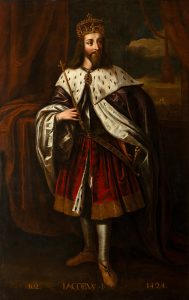
For James, life as the third Stewart monarch began ignominiously as a captive of King Henry IV. Although uncrowned for the first 18 years of his reign, he benefitted from an excellent education and was largely held in numerous southern castles in relative comfort. It wasn’t until the 1424 Treaty of Durham, which demanded instalments to pay his £40,000 ransom and a tactical marriage allying Scotland to England, that he was able to return, and his coronation was held on 21 May 1424 at Scone Palace.
James swiftly set about securing his legitimacy. Although his uncle, the Duke of Albany, died in 1420, the Albany Stewarts retained their thirst for power and James was quick to execute many of them as well as reassign lands and titles in an unwavering show of strength. It was, according to Stephen Boardman, lecturer in Scottish history at the University of Edinburgh, “an almost unprecedented judicial despatch of high-status noblemen, and that set the tone for much of his reign.”
Interested in law, James established the Court of Session, which still operates today, and levied taxes, which although earmarked for ransom payments, often went on the finer things, such as Linlithgow Palace instead.
James also believed in an assertive style of rule. While this had supporters, Boardman says that the “aristocracy was kept in line through a mixture of intimidation and fear” and, inevitably, this bred enemies. James was ultimately assassinated in a rather undignified manner as he tried to escape through a window in Blackfriars Monastery, Perth, in February 1437.
Boardman concludes: “James I’s reign is seen as decisively changing the balance of power between the king and his greatest subjects in practical and ideological terms.”
JAMES II
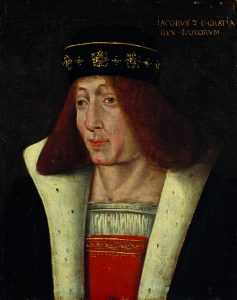
After his father’s unceremonious end, James II began his reign as the first Scottish monarch not to be crowned at Scone. On 25 March 1437, aged just six, his coronation was held at Holyrood Palace in Edinburgh.
His mother, Queen Joan Beaufort, was appointed regent but the notion of being ruled by an English woman was not well received, so the Earl of Douglas was given control of the kingdom while Queen Joan looked after her son.
James was hot property and the young king pin-balled between ambitious nobles. Chief among them were the Livingstons and the ‘Black’ Douglases. Even though James reached adulthood in 1449, it wasn’t until the 1455 Battle of Arkinholm that the Black Douglases were defeated. Meanwhile, James, distinguished by a red birthmark that gave him the nickname ‘Fiery Face’, grew into an able and liked leader. It’s suggested that although he had a temper, as seen with the impulsive stabbing of his guest Earl William of Douglas in 1452, people approved of his affable nature.
When he was killed by a misfiring cannon in 1460, aged just 29, he was “more powerful than any of his predecessors since Robert I,” according to Venning.
While James will always be associated with the destruction of the Black Douglases and ensuring dynastic security, his marriage to Mary of Guelders played an important role in Scotland’s cultural evolution.
By establishing links with the dukes of Burgundy, who were, as Boardman says, “regarded as leading lights in the European Renaissance,” James opened the Scottish court to “Burgundian cultural, religious and artistic influences,” thereby paving the way for Scotland’s very own Renaissance.
Our series on the early Kings of Scotland will continue in the next issue of Scotland. Get your copy of the January/Feburary issue, here.
Read more:
The early kings of Scotland: The end of the House of Dunkeld
The real Macbeth and the House of Dunkeld: Early Kings of Scotland

SCOTLAND MAGAZINE
Published six times a year, every issue of Scotland showcases its stunning landscapes and natural beauty, and delves deep into Scottish history. From mysterious clans and famous Scots (both past and present), to the hidden histories of the country’s greatest castles and houses, Scotland‘s pages brim with the soul and secrets of the country.
Scotland magazine captures the spirit of this wild and wonderful nation, explores its history and heritage and recommends great places to visit, so you feel at home here, wherever you are in the world.
